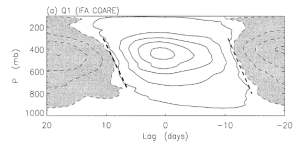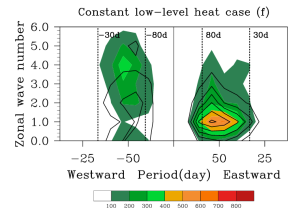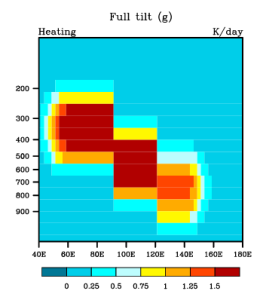The Madden-Julian Oscillation (MJO) has many curious features that currently have evaded a fundamental understanding. One such feature is the “westward tilt with height” that is often seen in analysis such as this lagged humidity composites from Kiladis et al. (2005),
or this lagged composite of diabatic heating from the TOGA-COARE field campaign in Lin et al. (2004),
Many convectively coupled phenomena exhibit a tilted vertical structure, and, presumably, this is caused by convection. However, it’s difficult to say whether this tilt is important at all! People often speculate that a model might produce a better MJO if it could reproduce a tilted heating structure, but some studies have shown that a model can get a decent MJO without any tilt whatsoever (Maloney et al. 2010).
This recent paper by Lappen and Scumacher (2014) seeks to show whether or not the tilt is a necessary component of the MJO. Overall, they find that the tilt of the heating profile is NOT absolutely necessary, but it does have a noticeable effect.
I suspect their results can be mostly explained using the concept of gross moist stability (GMS), and how it relates to heating modes. Specifically, it appears that the simulations that get the most robust MJO, tend to have more low-level heating in the time mean. A bottom-heavy heating profile should lower the GMS, and thus make a more favorable environment for moisture modes to exist. This would help explain the result in Fig. 14, in which they prescribe a bottom-heavy heating over a large area, which results in a pretty good MJO spectral signature.
I find this paper very intriguing, mostly because of the method they use to prescribe heating in a global model. I’ve heard many people discuss trying similar approaches, but there are several problems with trying to artificially enhance something that you don’t understand. I commend this study for their effort.
Their method was to prescribe heating patterns based on the RMM index. The heating structures were very coarse, but seemed to be a good test of the hypothesis.
The heating structures did a lot to improve the spectral characteriztics of the MJO, but I was puzzled by the variance map of filtered U850 and precipitation. Observations put the highest variance south of the equator, while the model with enhanced heating has the highest intra-seasonal variance north of the equator. Furthermore, the simulations don’t show colacted variance maxima for these variables, unlike observations.
This leaves me feeling skeptical about whether we can really call the variability in these simulations “the MJO”. The lagged correlation Hovmoller plots also show a lack of coherence. Although I really like this work, a more coherent picture of the MJO needs to emerge for me to accept the conclusion that the tilt of diabatic heating is not an essential characteristic of the MJO.
A better test of the importance of tilted heating would be to devise a way to affect the heating without affecting the mean GMS. Maybe a convective parameterization with fixed vertical heating structure could be used? Or maybe we could fix the mean vertical heating structure and allow the convection to only alter the anomalous heating?





